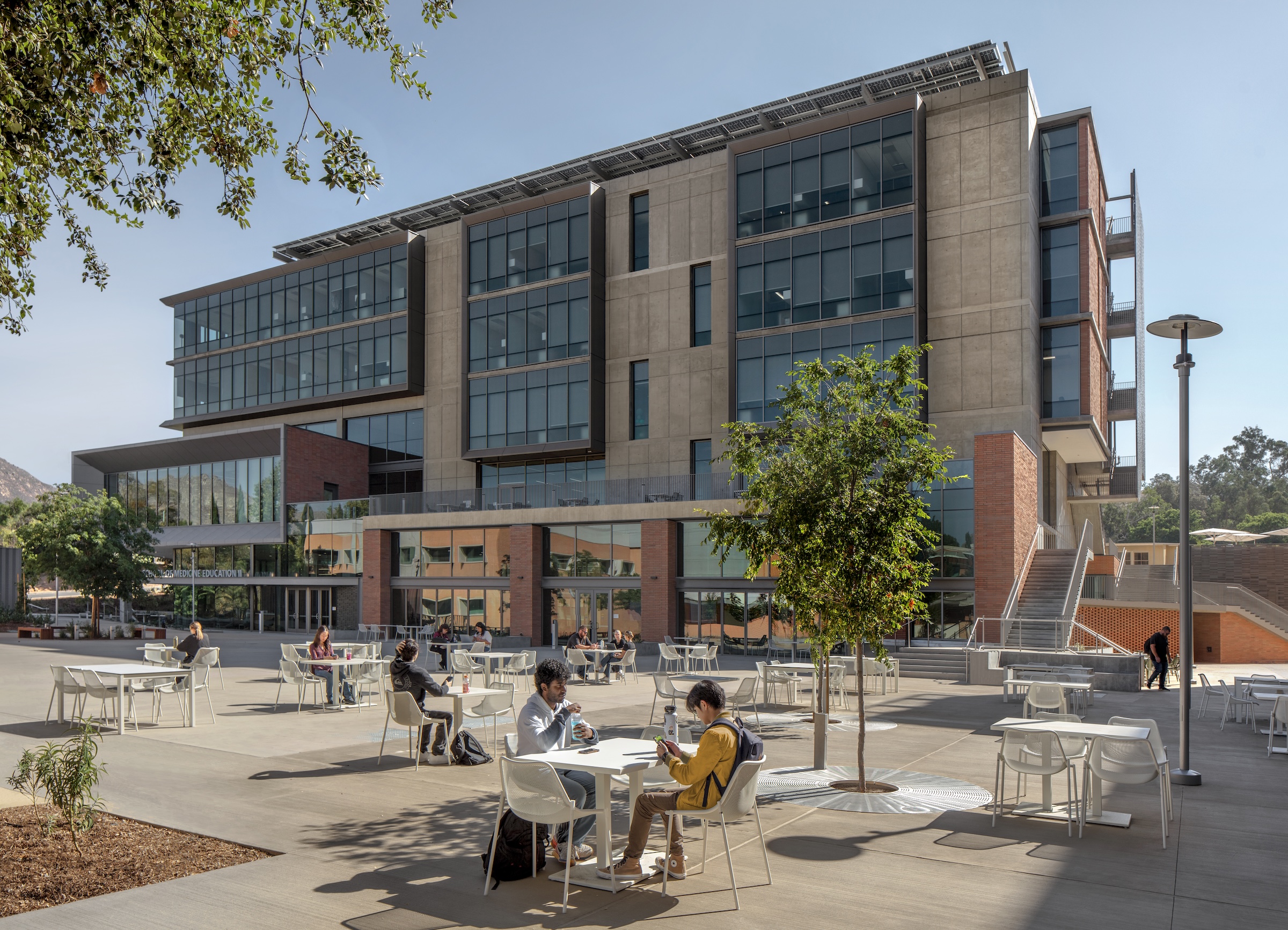The University of California, Riverside, School of Medicine has opened the 94,576-sf, five-floor Education Building II (EDII). Created by the design-build team of CO Architects and Hensel Phelps, the medical school’s new home supports team-based student learning, offers social spaces, and provides departmental offices for faculty and staff.
The learning spaces are located on the first three floors, while the administration and shared functions are housed on the top two floors. The building features interactive classrooms, 15 case-based group seminar rooms, variously sized study rooms, and additional study and amenity spaces.
The building includes materials, such as cast-in-place concrete, brick, terracotta, and glass, that are meant to be both beautiful and durable, lasting for generations.
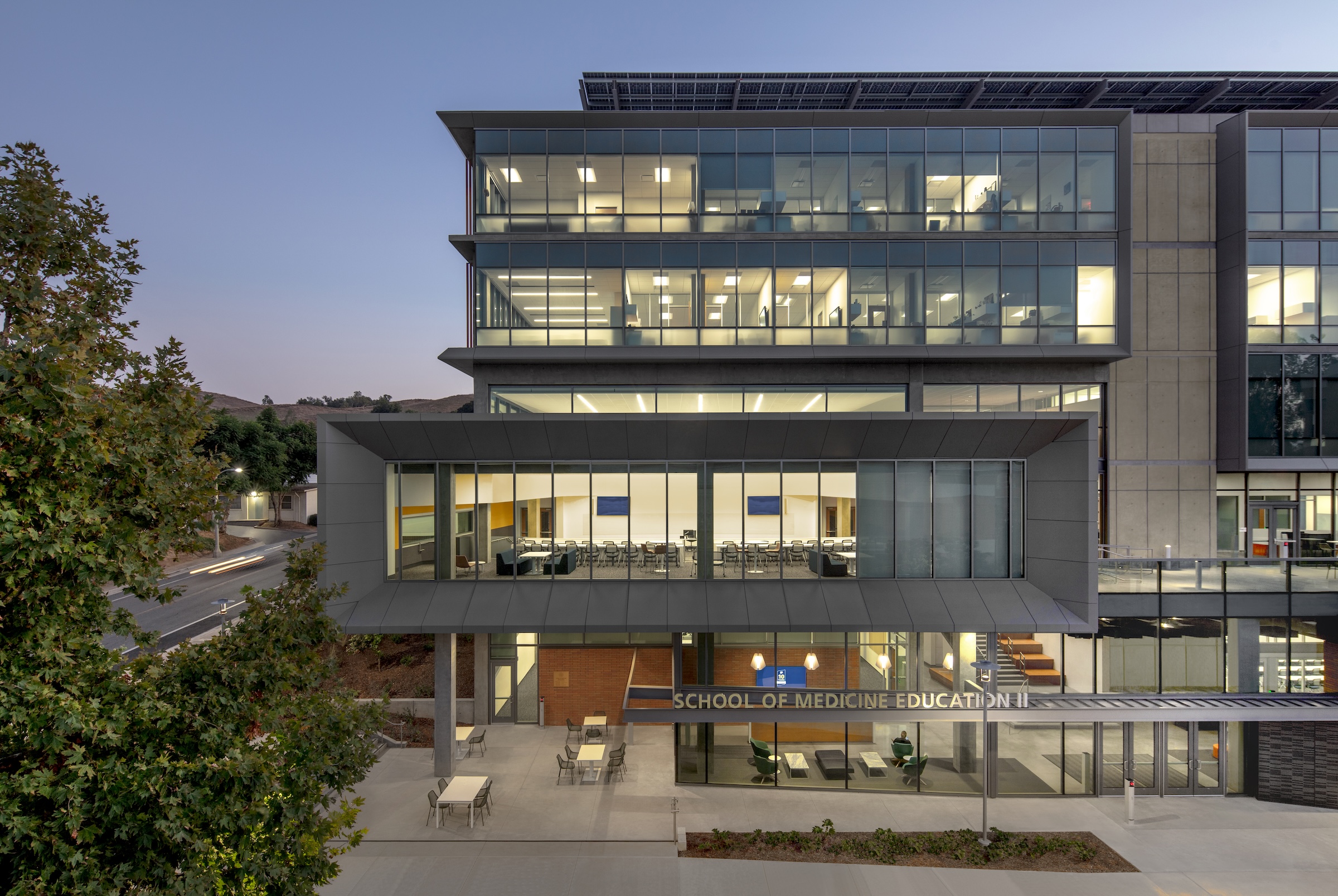
EDII’s design emphasizes transparency to help demystify medical education and welcome prospective students from diverse backgrounds. The use of transparency and shading leverages passive light, prevailing breezes, and solar heat gain. A rooftop solar array contributes to the building’s energy efficiency.
Each façade is optimized for the climate and for varying levels of sun exposure throughout the day. On the east façade, vertical glass fiber reinforced concrete (GFRC) fins create extended shadows and protect the interior from the harsh morning light. Painted perforated aluminum panels shade the east and west exit stairs as well as the south façade’s windows. The porous north façade features abundant glass and walls opening to the courtyard.
Located in a drought-prone region, the building restores the site’s natural vegetative conditions. The ground-level plaza connects the surrounding buildings.
Inside, a three-story perforated gypsum mural depicts an abstraction of orange groves, referencing the region’s history.
On the Building Team:
Owner: UCR School of Medicine
Architect/interior designer: CO Architects
Contractor: Hensel Phelps
Landscape architect: Spurlock Landscape Architects
MEP engineer: P2S, Inc.
Structural engineer, waterproofing, LEED consultant: Thornton Tomasetti
Civil engineer: Albert A. Webb Associates
Geotechnical engineer: Langan
Fire protection engineer: Woden Fire
Acoustics consultant: Arpeggio
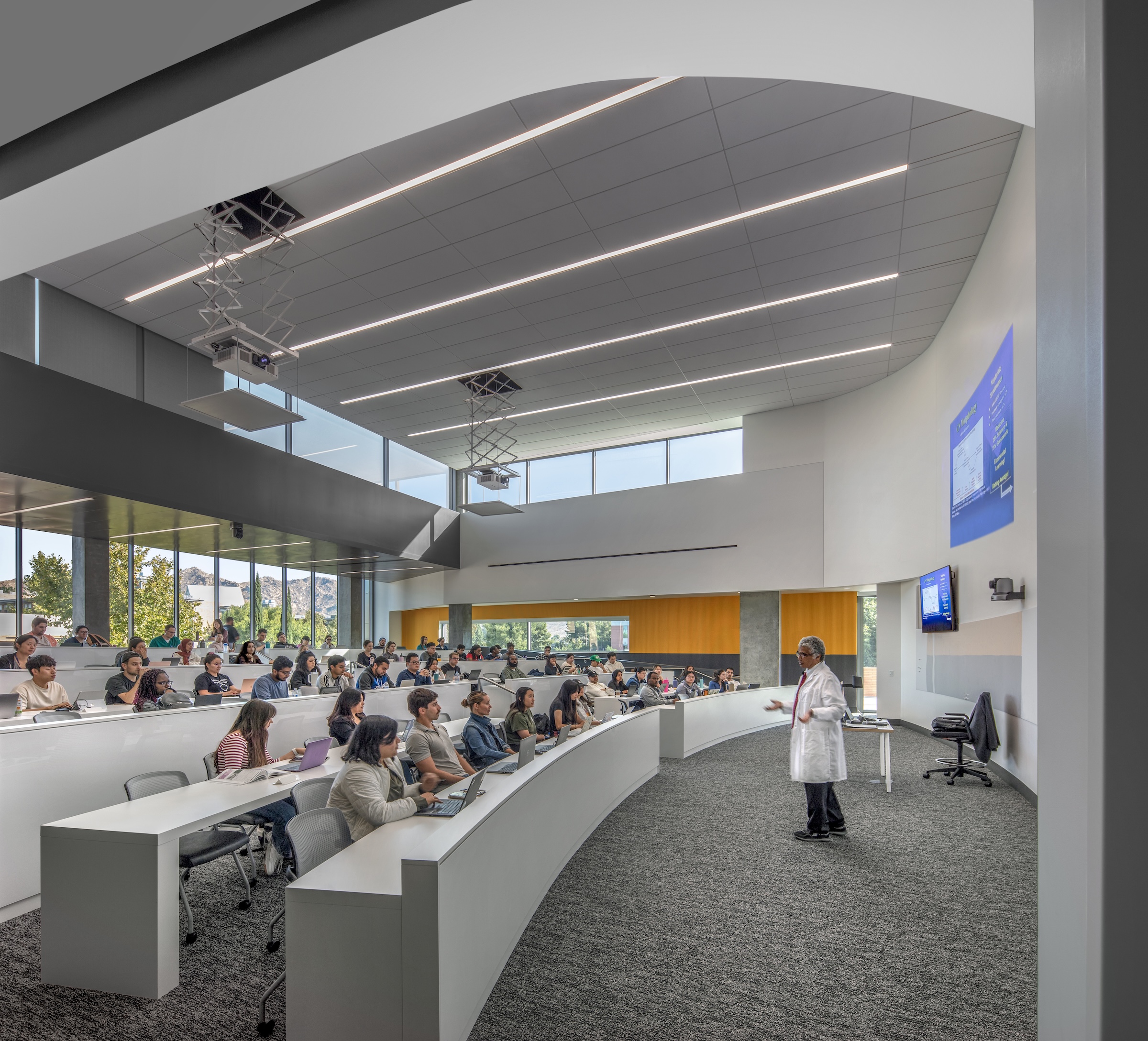
Here is the project essay from the design-build team of Hensel Phelps and CO Architects:
The School of Medicine (SOM) Education Building II (EDII) fulfills the mission of the University of California, Riverside (UCR), to train a diverse workforce of physicians to support the medically underserved Riverside County region of Southern California. The building by the design-build partnership of Hensel Phelps + CO Architects creates a new home for the medical school by incorporating a wide range of team-based student learning, social spaces, and departmental offices for faculty and staff into one 95,476-square-foot, five-story structure. Strategically located and highly visible on campus, the EDII amplifies the SOM’s identity as a forward-thinking medical school and showcases the mission and dedication of medical education to undergraduates and community members alike.
The design team and client shared the vision of crafting a building that supports its occupants and creates an environment to empower students throughout their academic experience and into their careers. The architecture utilizes transparency to demystify medical education, welcoming prospective students from diverse backgrounds to learn about the requirements and daily activities of medical students. EDII’s design is meant to be both beautiful and durable, utilizing materials—such as cast-in-place concrete, brick, terracotta, and glass—that fit within the campus context and will last for generations.
Each façade is optimized for the climate and levels of sun exposure throughout the day. Vertical glass fiber reinforced concrete (GFRC) fins on the east façade cast dramatic extended shadows while protecting interior spaces from the harsh morning light. Painted perforated aluminum panels—featuring custom patterns that resonate with the scale and pattern of the building’s brickwork—shade the east and west exit stairs, screening the stairs behind and creating a larger architectural feature on the façades.
The same panels are used on the south façade to shade individual windows. The staggered window placement is interspersed with brick infill stacked vertically in rows to signify the use of the brick as a façade skin, rather than as load-bearing elements. The north entrance face of the building is porous, both visually with abundant glass and structurally with walls opening out to the courtyard. Inside, a three-story perforated gypsum mural represents an abstraction of orange groves as a nod to the region’s history as the Orange Empire.
The materials palette provides flexibility for expansion over time and allowed construction details to be easily executed and built. During constructability review, the team modeled the different exterior connections and material intersections to digitally ensure the details were constructible and would stand the test of time with limited or no maintenance. Utilizing the design-build delivery method, the EDII was able to fit within a strict budget and a demanding schedule.

The EDII was designed with long-term sustainability in mind to ensure it will remain fully functional for generations to come while minimizing its carbon footprint. Located in a drought-prone region, the building defends and restores the natural vegetative conditions of the site. The EDII’s use of transparency and shading optimizes passive elements of light, prevailing breezes, and solar heat gain. The interiors and exteriors utilize durable, easy-to-maintain, and sustainable building materials, as well as low/no-VOC materials that promote healthy interior air quality and performance. A 200-kilowatt solar array on the roof contributes to its energy efficiency. The EDII will achieve LEED Platinum through its multiplicity of sustainability strategies in all building systems.
To maximize EDII’s lifespan, the design is flexible and adaptable to respond to growth as needs and pedagogy change. The building is organized with all the high-activity and student-centric learning spaces on the first three floors, which are more accessible and feature indoor/outdoor spaces, while administration and shared functions are located on the upper two floors. The EDII collocates most of the medical school’s staff, administrators, and faculty in the same building for the first time, creating greater efficiencies and moments for collaboration.
The medical school’s academic programs are supported by interactive classrooms, 15 case-based group seminar rooms, ample and various sized study rooms, and additional study and amenity spaces that work cohesively to integrate and support student engagement throughout the day and into the night. Throughout the building, the design team identified opportunities to enhance the program with high-profile spaces, such as an interactive tiered classroom that is universally accessible and features an abundance of daylight, state-of-the-art technology, writeup spaces, and informal lounge seating for breakout sessions.
Each level of the EDII capitalizes on the mild Southern California climate by providing outdoor environments that offer views and opportunities for collaboration, socialization, and reflection. An expansive plaza on the ground level connects and organizes the surrounding buildings, creating a new SOM Plaza for a wide variety of School of Medicine and campus events. EDII reinvigorates the area of campus in which it’s sited, creating opportunity for expansion to the south by developing a “Medical Walk”—a pathway that traverses from the health sciences library, across EDI (SOM’s first building), and through EDII, establishing an armature for future expansion.
Located on a constrained site, EDII uses the challenging terrain in innovative ways to create connections both externally to the campus and internally for users. Each grade level provides accessible opportunities to enter the building, maximizing the topographical nature of the site. By embracing the site’s challenges, EDII establishes meaningful and varied campus interfaces along all sides of the building. The design enriches the campus experience and encourages engagement with the larger campus and community of Riverside.
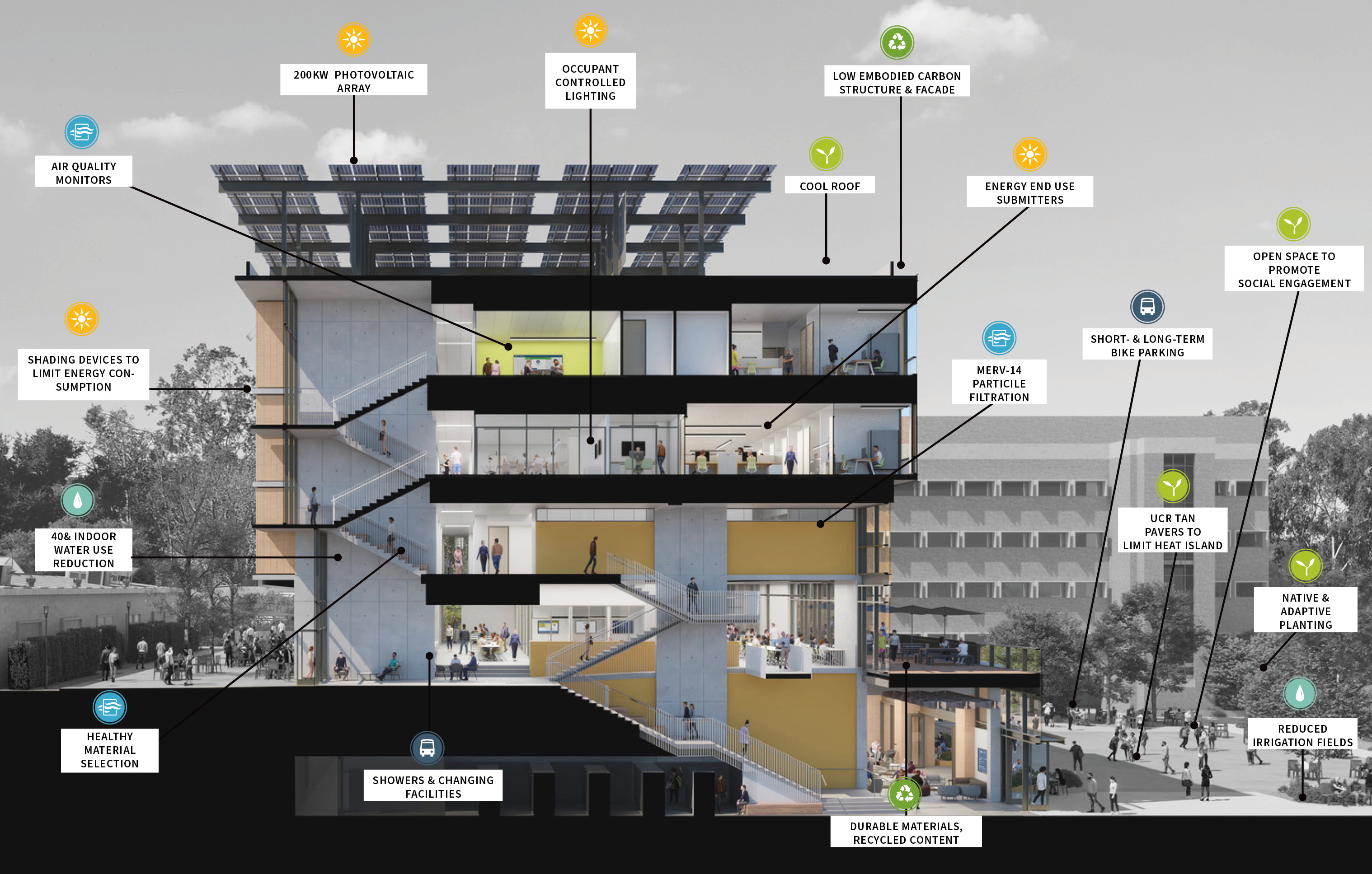
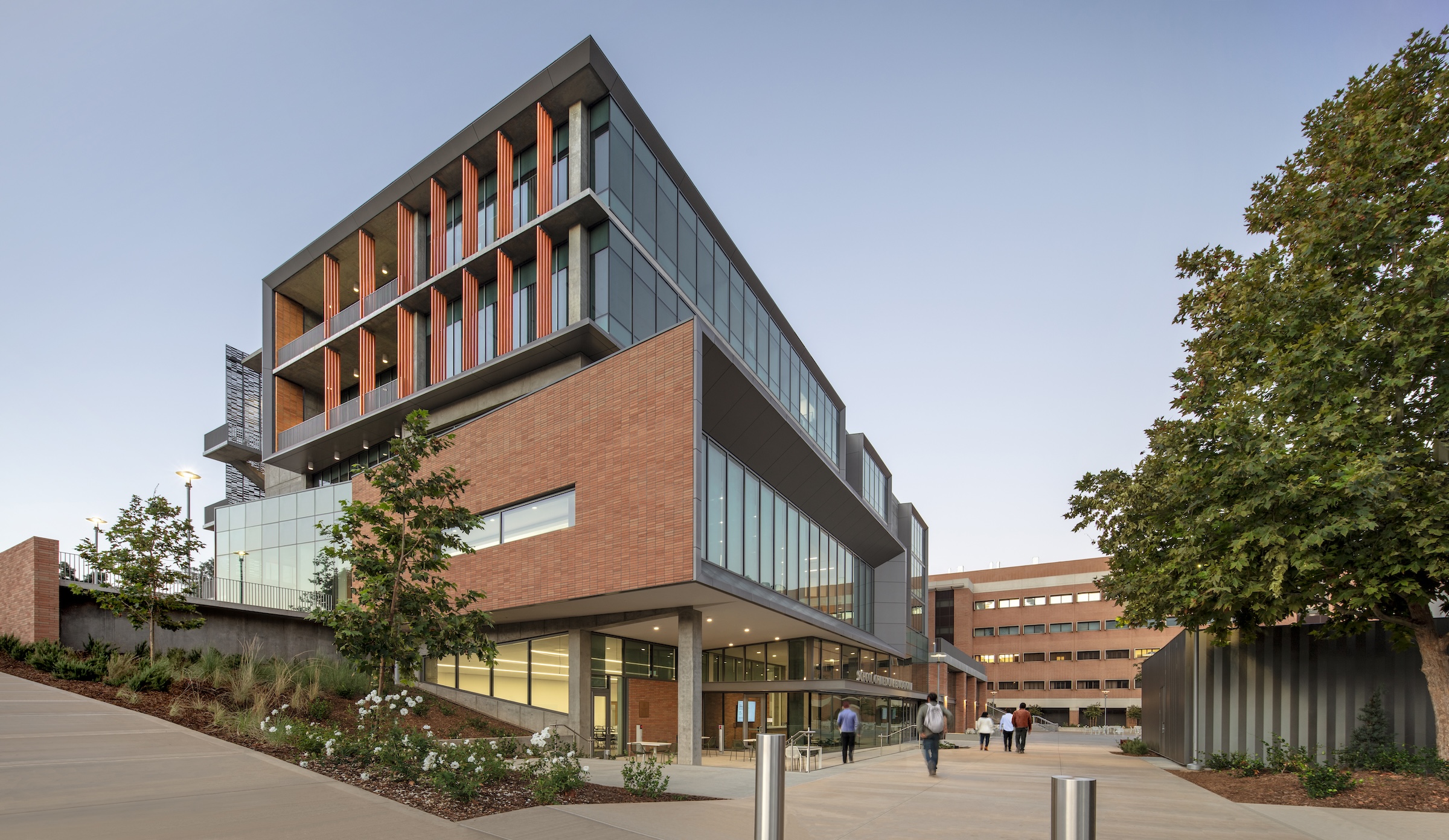
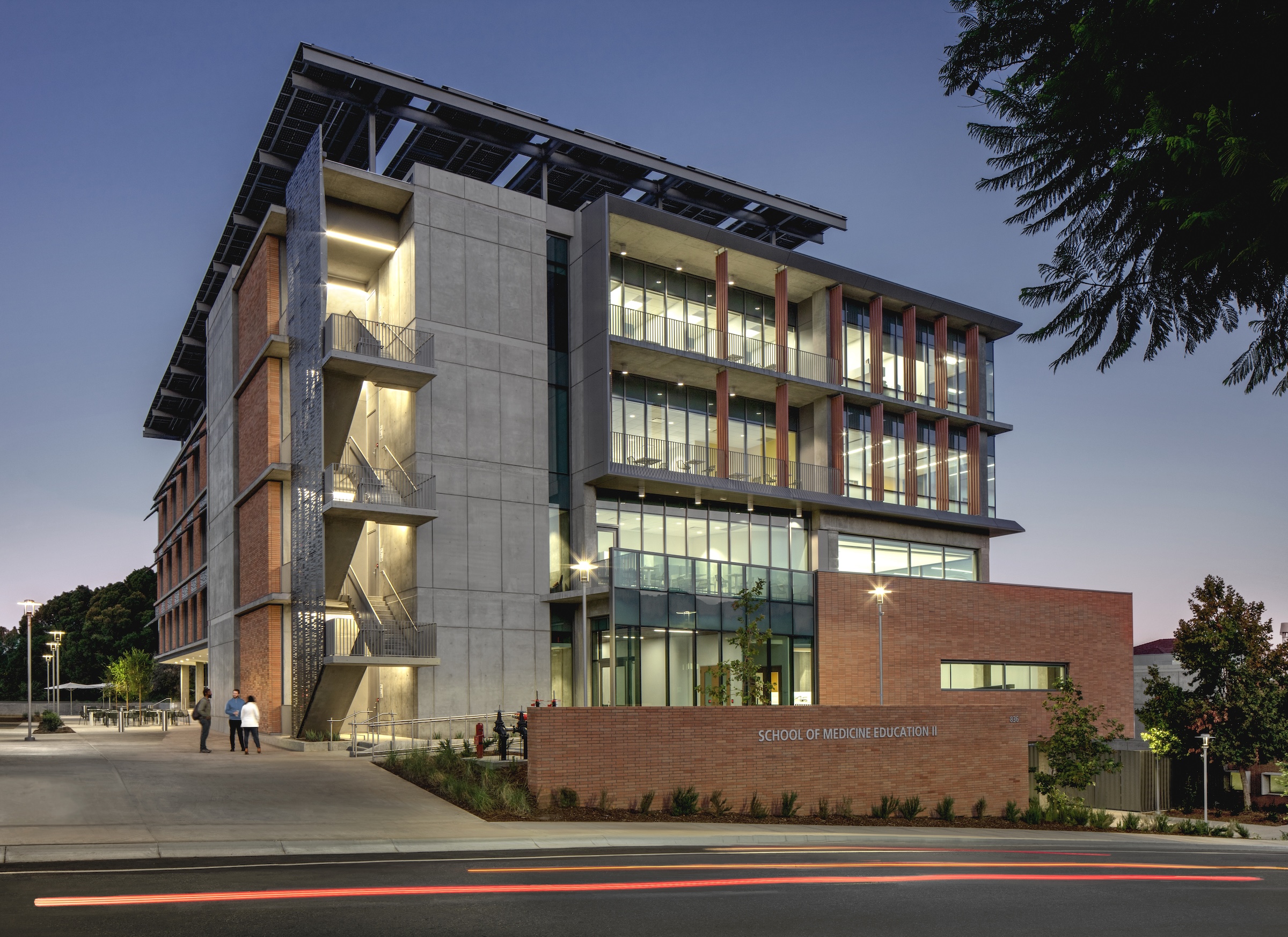
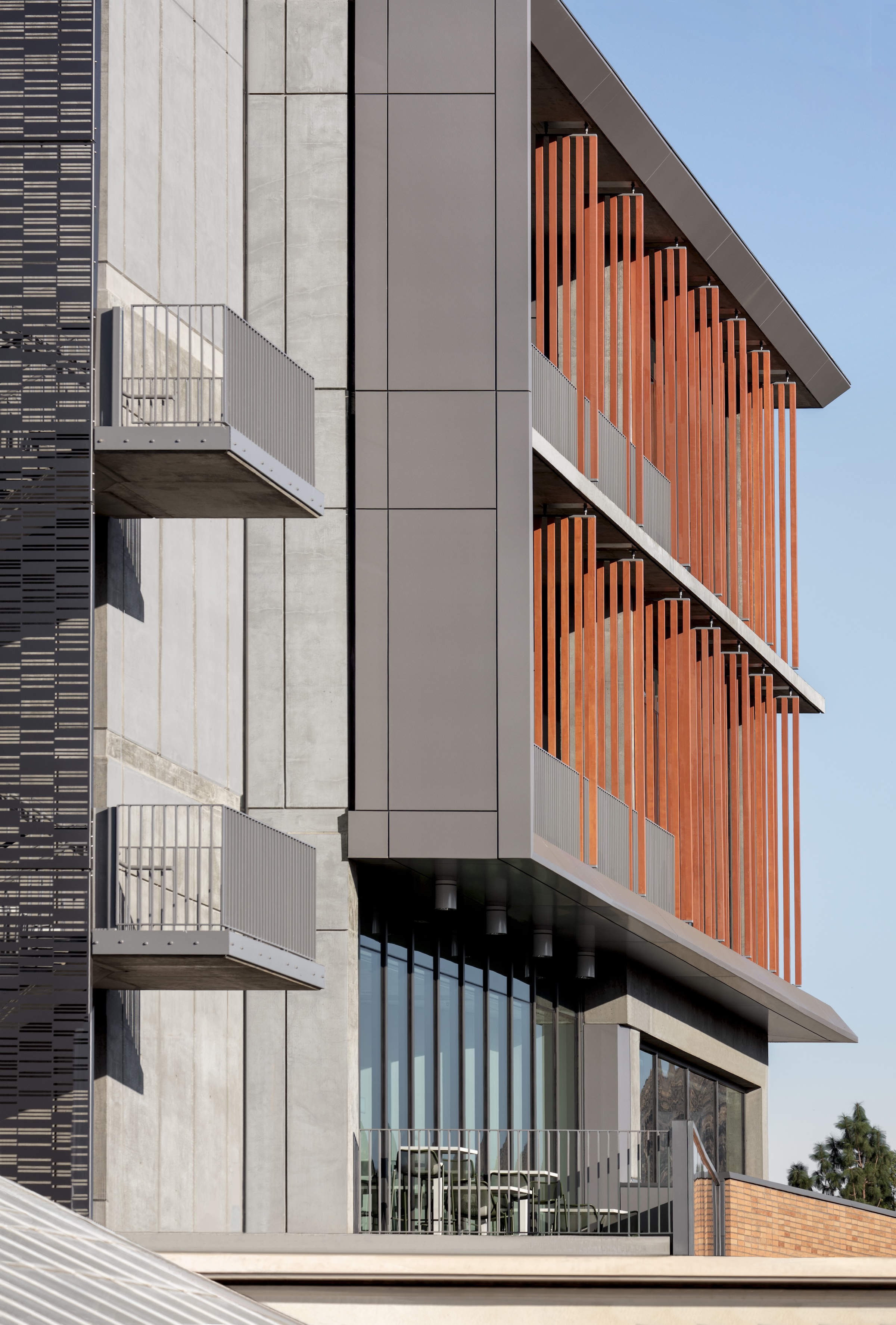

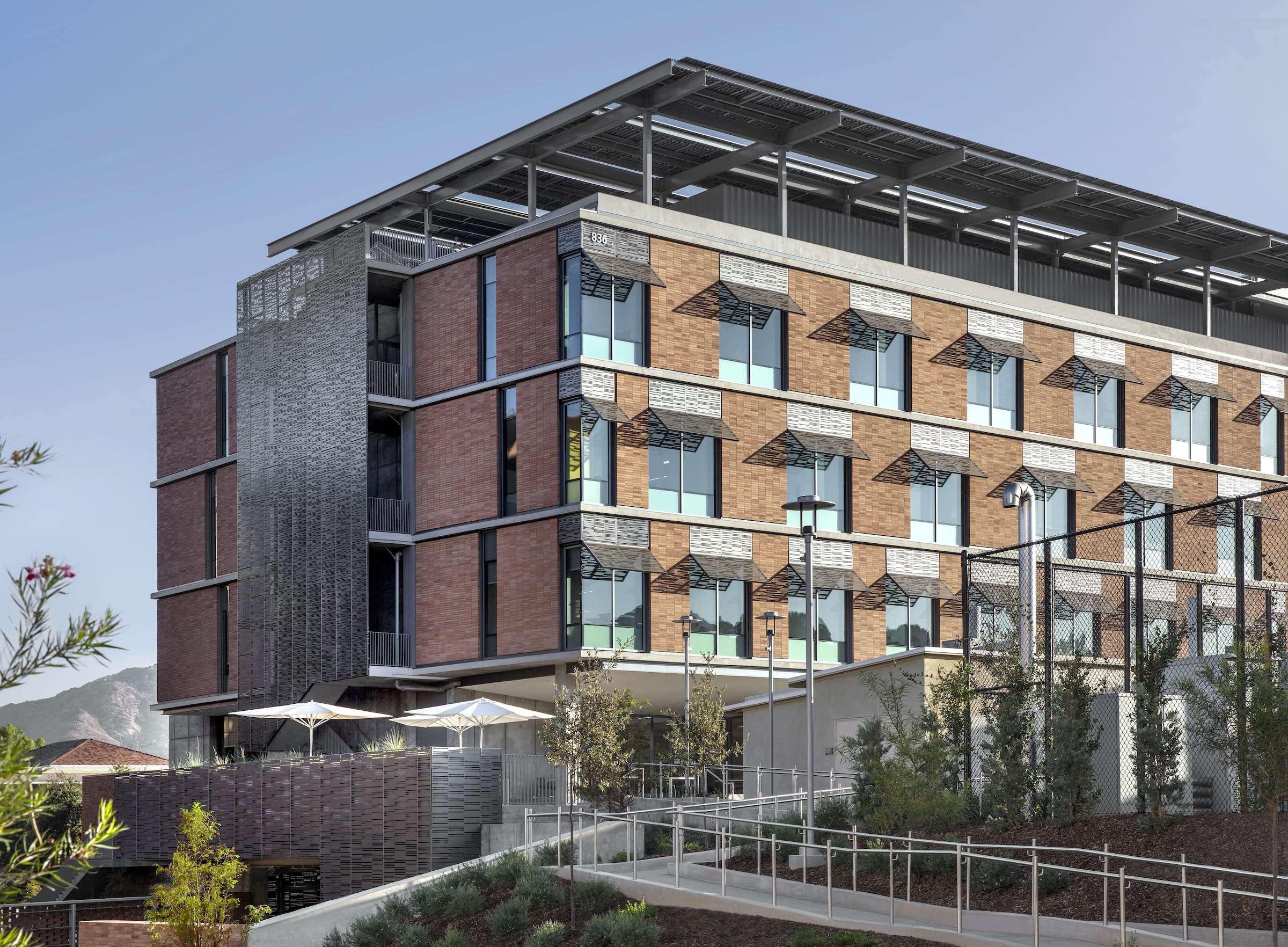

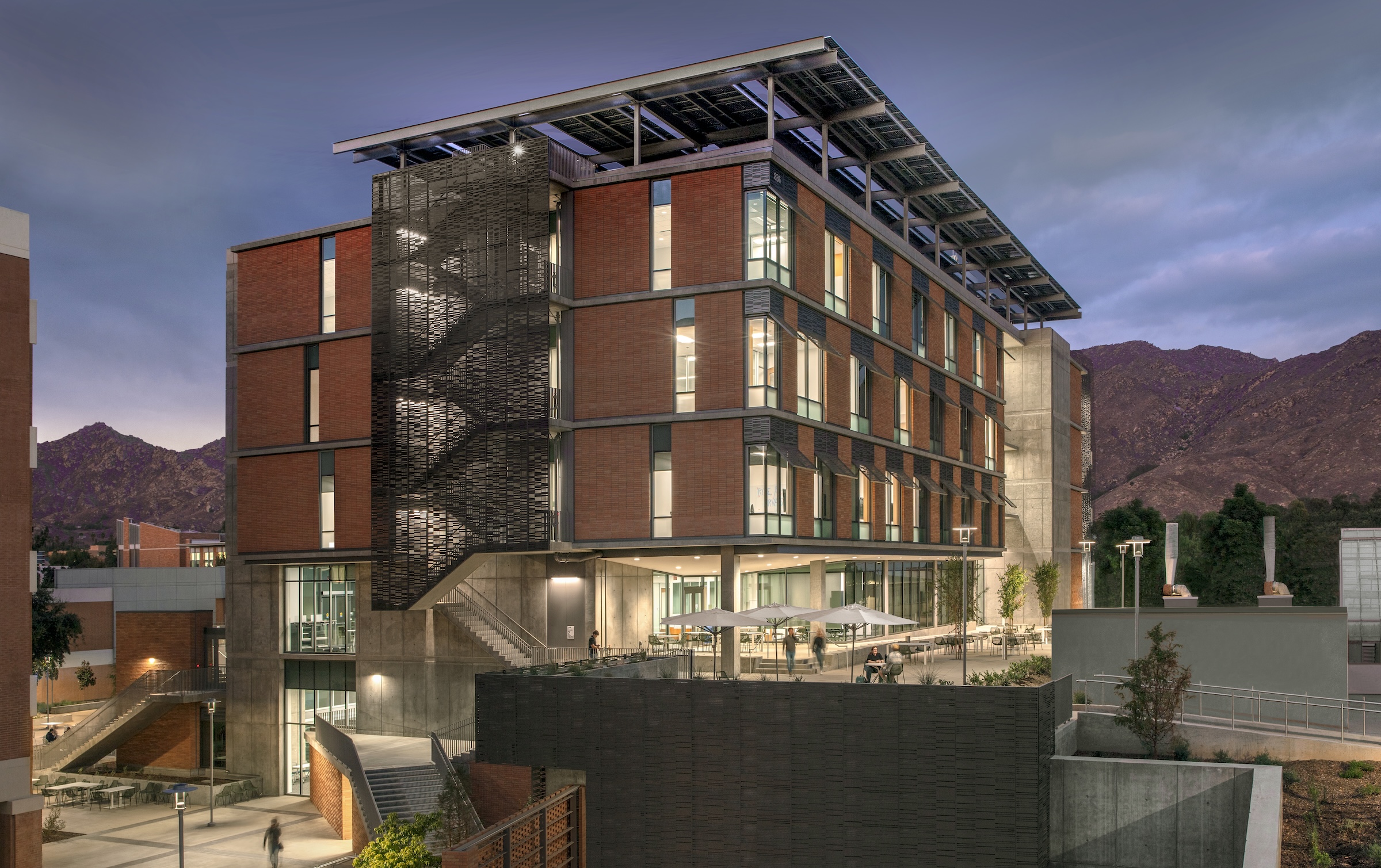
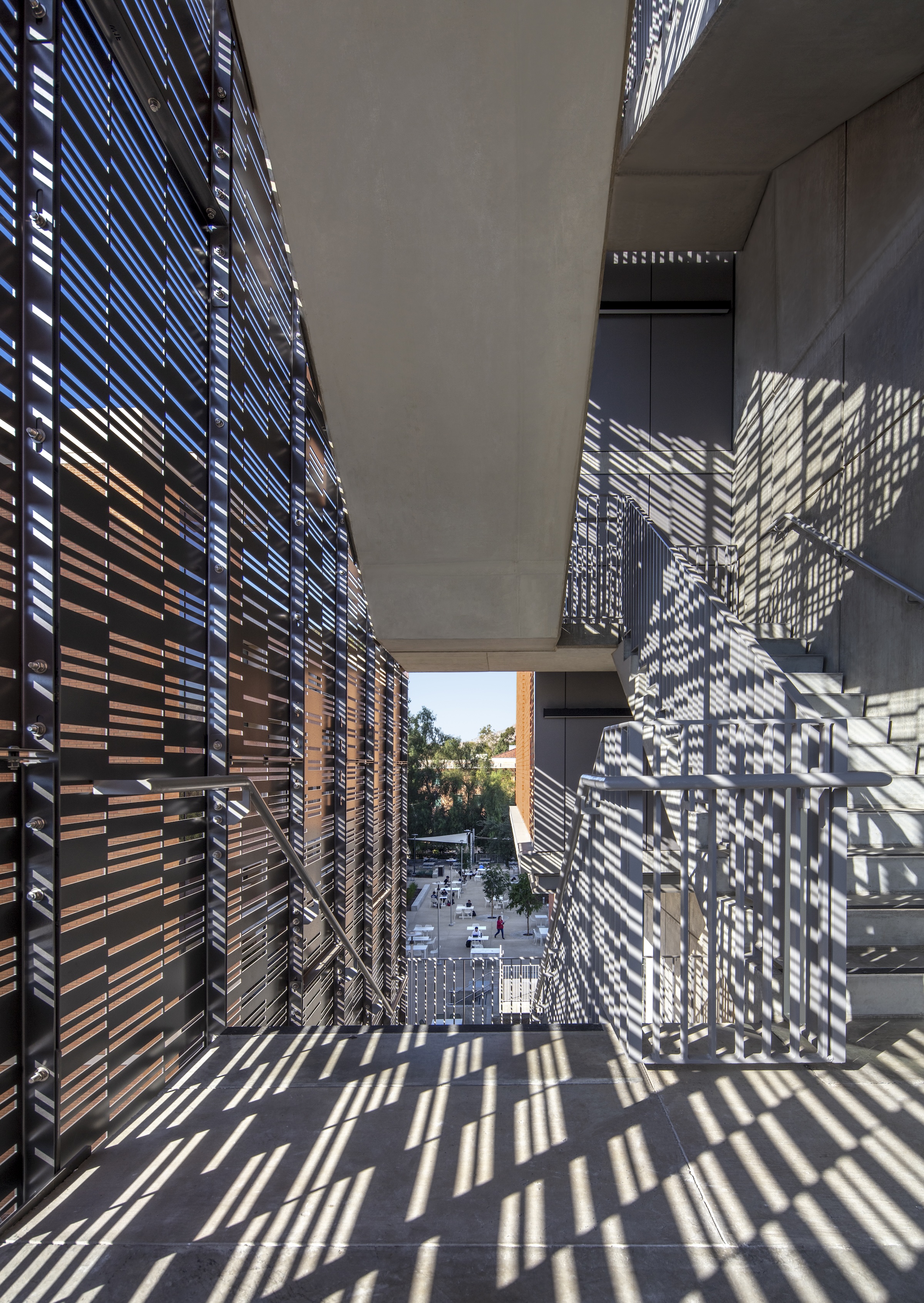
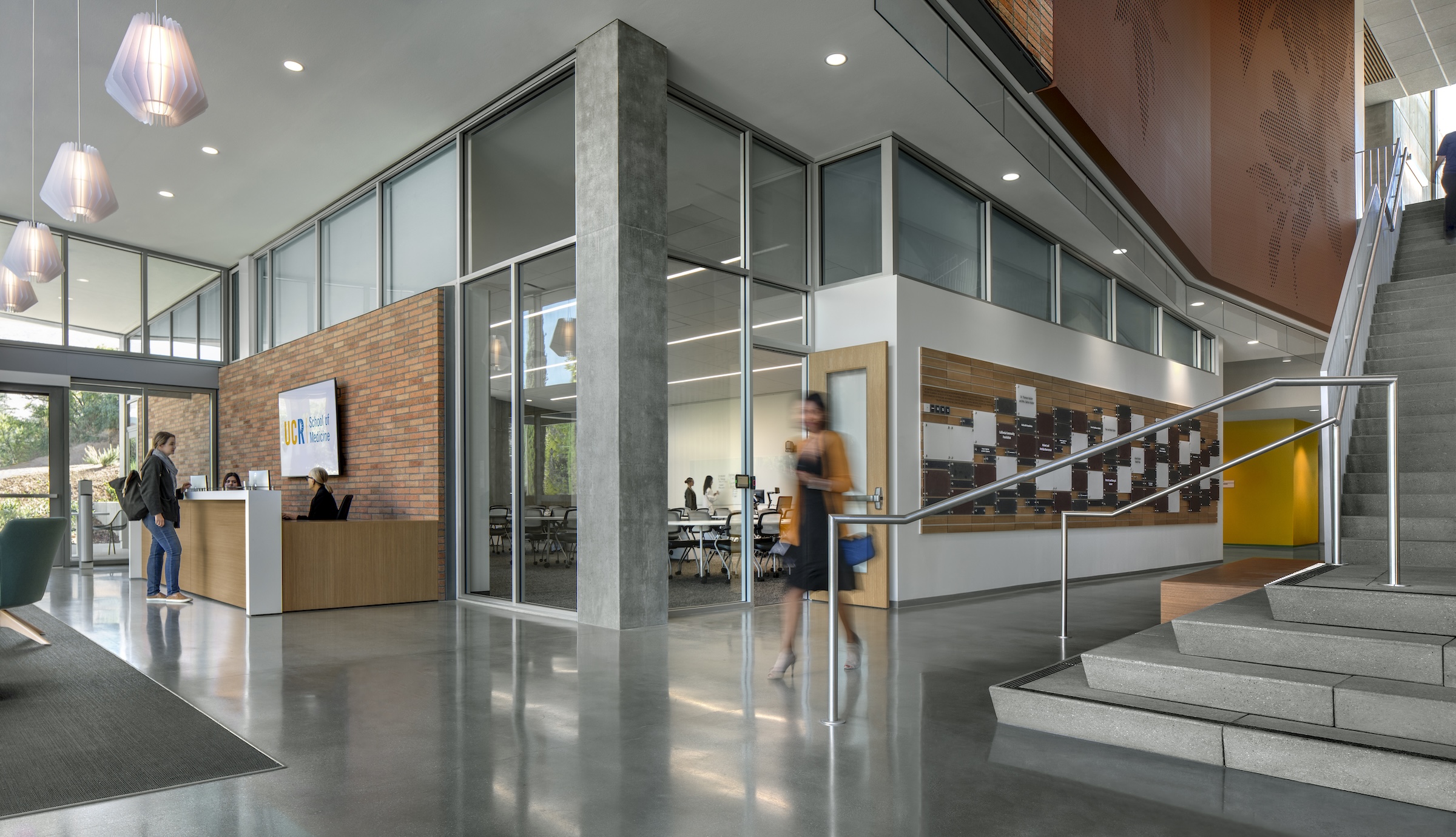

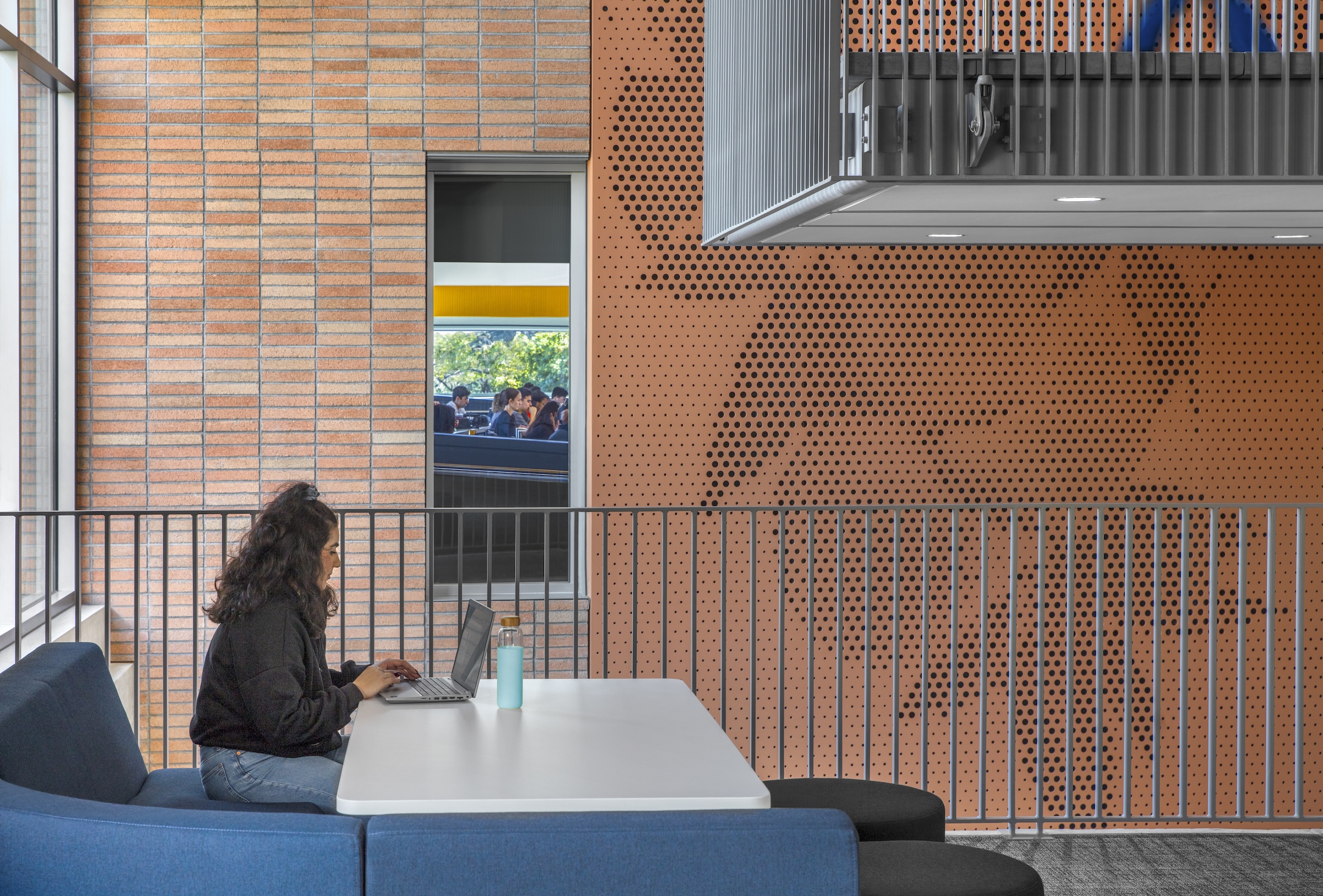
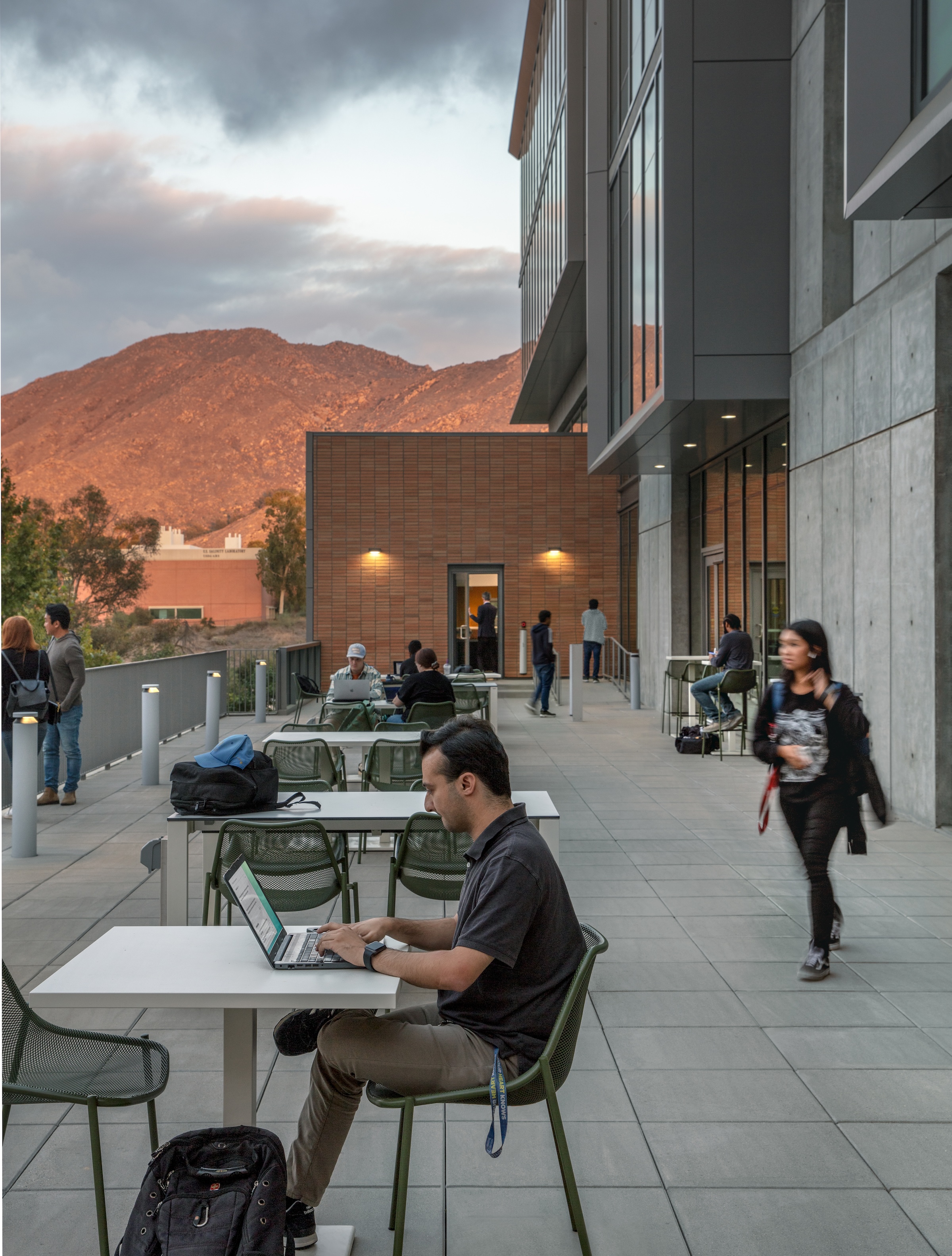
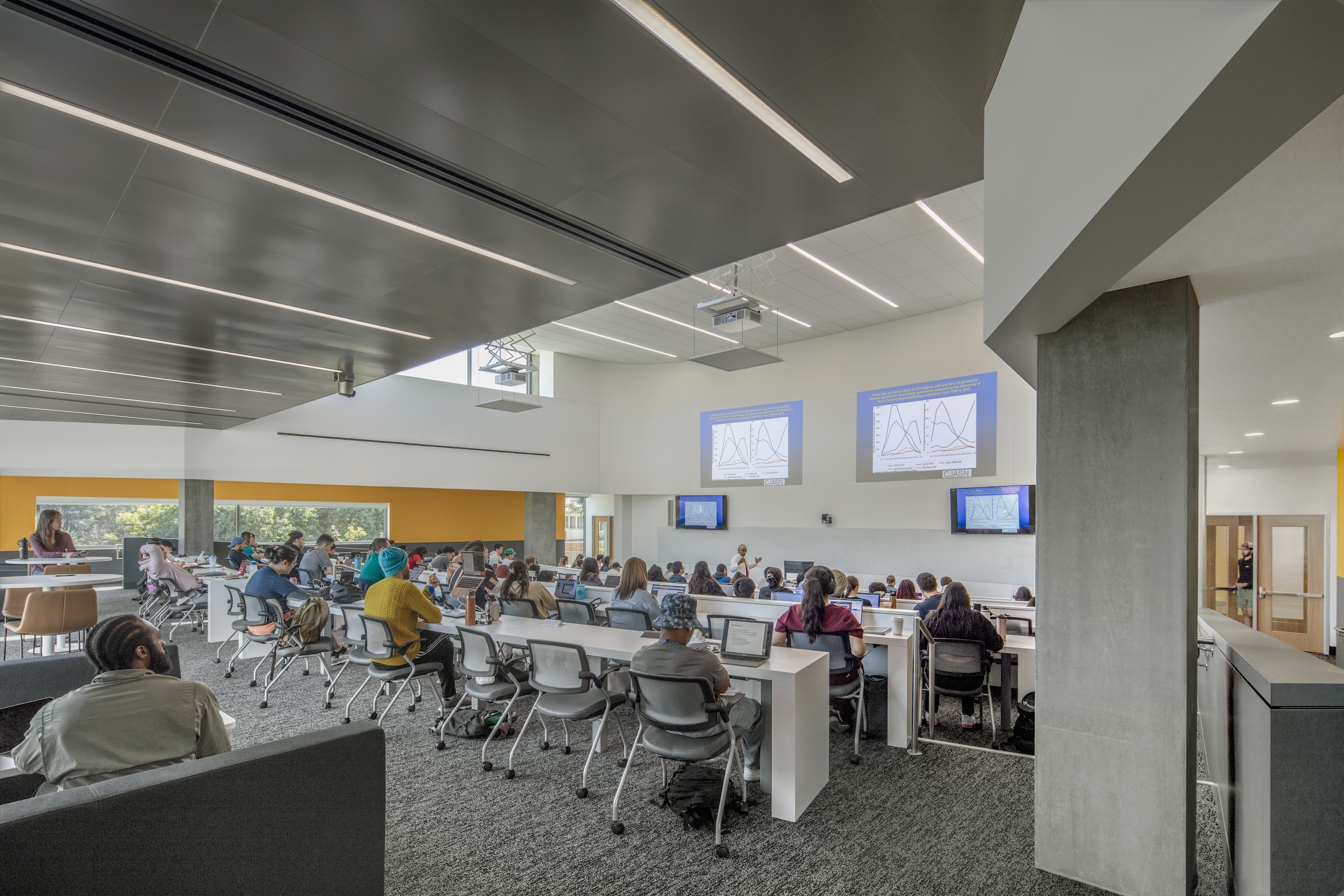

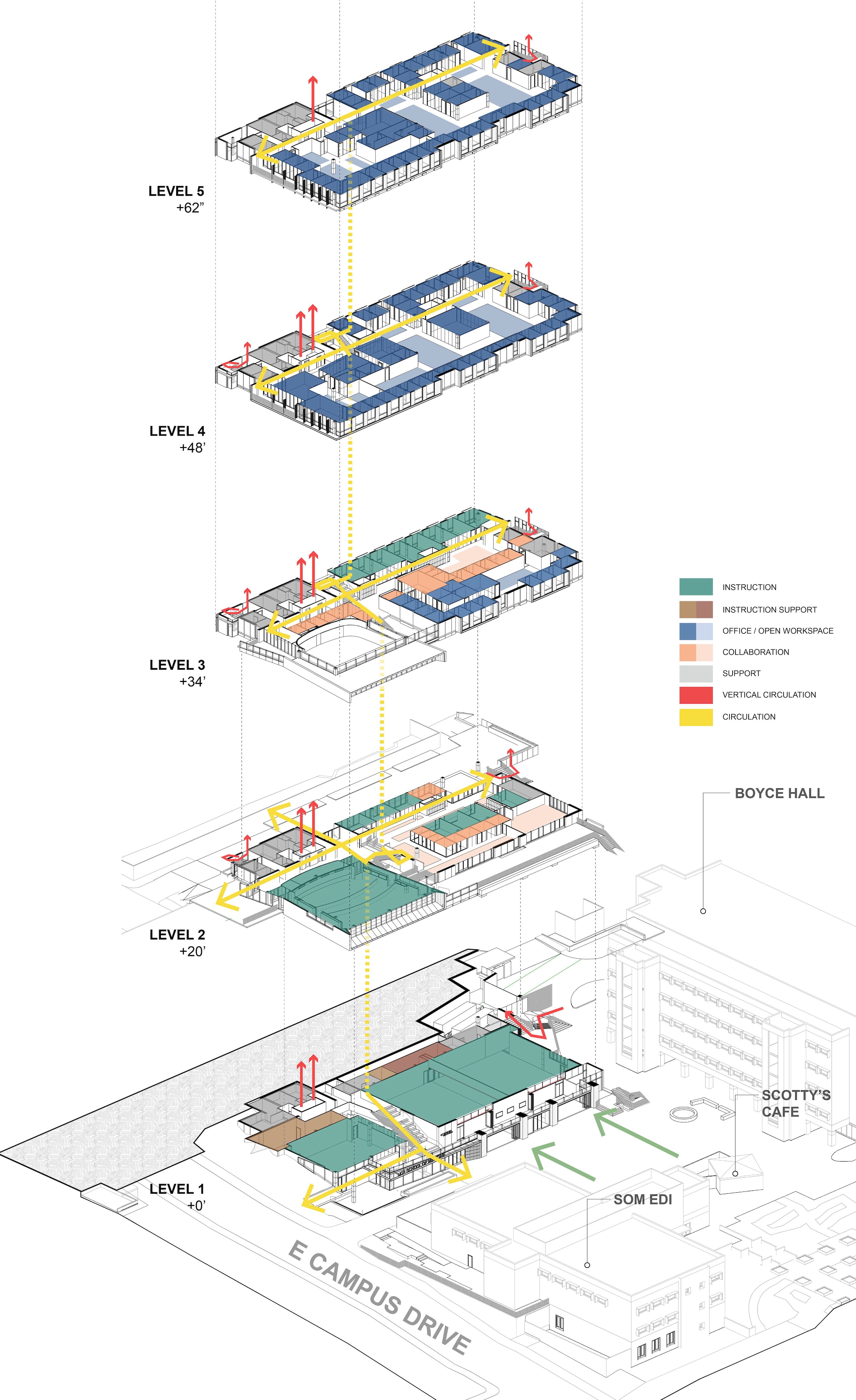
Related Stories
| Aug 11, 2010
Opening night close for Kent State performing arts center
The curtain opens on the Tuscarawas Performing Arts Center at Kent State University in early 2010, giving the New Philadelphia, Ohio, school a 1,100-seat multipurpose theater. The team of Legat & Kingscott of Columbus, Ohio, and Schorr Architects of Dublin, Ohio, designed the 50,000-sf facility with a curving metal and glass façade to create a sense of movement and activity.
| Aug 11, 2010
Residence hall designed specifically for freshman
Hardin Construction Company's Austin, Texas, office is serving as GC for the $50 million freshman housing complex at the University of Houston. Designed by HADP Architecture, Austin, the seven-story, 300,000-sf facility will be located on the university's central campus and have 1,172 beds, residential advisor offices, a social lounge, a computer lab, multipurpose rooms, a fitness center, and a...
| Aug 11, 2010
University of Florida's traditionally modern graduate building
The University of Florida's Hough Hall Graduate Studies Building was designed by Rowe Architects, Tampa, and Sasaki Associates, Boston, to blend with the school's traditional collegiate gothic architecture outside, but reflect a 21st-century education facility inside. Tallahassee-based Ajax Building Corporation is constructing the $19 million facility, which will have traditional exterior detai...
| Aug 11, 2010
Construction under way on LEED Platinum DOE energy lab
Centennial, Colo.-based Haselden Construction has topped out the $64 million Research Support Facilities, located on the U.S. Department of Energy’s National Renewable Energy Laboratory (NREL) campus in Golden, Colo. Designed by RNL and Stantec to achieve LEED Platinum certification and net zero energy performance, the 218,000-sf facility will feature natural ventilation through operable ...
| Aug 11, 2010
Stimulus funding helps get NOAA project off the ground
The award-winning design for the National Oceanic and Atmospheric Administration’s new Southwest Fisheries Science Center replacement laboratory saw its first sign of movement last month with a groundbreaking ceremony held in La Jolla, Calif. The $102 million project is funded primarily by the American Recovery and Reinvestment Act.
| Aug 11, 2010
New Jersey's high-tech landscaping facility
Designed to enhance the use of science and technology in Bergen County Special Services' landscaping programs, the new single-story facility at the technical school's Paramus campus will have 7,950 sf of classroom space, a 1,000-sf greenhouse (able to replicate different environments, such as rainforest, desert, forest, and tundra), and 5,000 sf of outside landscaping and gardening space.
| Aug 11, 2010
Florida International University's cantilevered design
Suffolk Construction's Miami-Dade business unit is serving as GC for the $14 million School of International and Public Affairs building at the University Park Campus of Florida International University. Designed by Arquitectonica, Miami, the five-story, 58,408-sf building will have a café and three auditoriums on the ground level; the largest auditorium will have a 40-foot cantilever abov...
| Aug 11, 2010
Research Facility Breaks the Mold
In the market for state-of-the-art biomedical research space in Boston's Longwood Medical Area? Good news: there are still two floors available in the Center for Life Science | Boston, a multi-tenant, speculative high-rise research building designed by Tsoi/Kobus & Associates, Boston, and developed by Lyme Properties, Hanover, N.
| Aug 11, 2010
Precast All the Way
For years, precast concrete has been viewed as a mass-produced product with no personality or visual appeal—the vanilla of building materials. Thanks to recent technological innovations in precast molds and thin veneers, however, that image is changing. As precast—concrete building components that are poured and molded offsite—continues to develop a vibrant personality all it...
| Aug 11, 2010
Living and Learning Center, Massachusetts College of Pharmacy & Health Sciences
From its humble beginnings as a tiny pharmaceutical college founded by 14 Boston pharmacists, the Massachusetts College of Pharmacy & Health Sciences has grown to become the largest school of its kind in the U.S. For more than 175 years, MCPHS operated solely in Boston, on a quaint, 2,500-student campus in the heart of the city's famed Longwood Medical and Academic Area.


